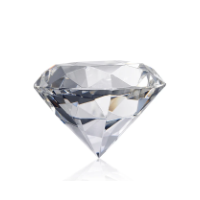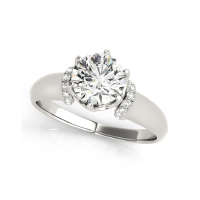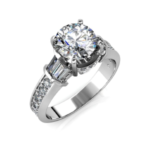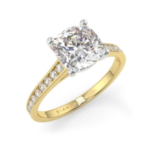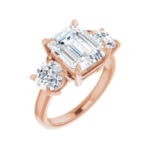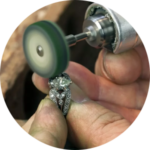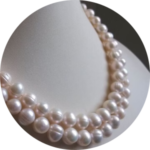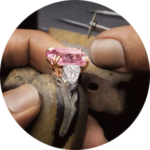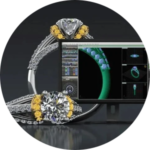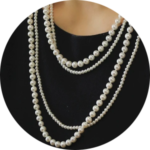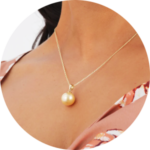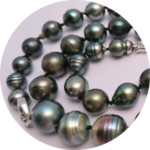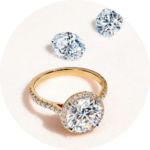When planning a wedding, one of the most common points of confusion for couples is the difference between a wedding band and a wedding ring. Are they the same thing? Should you buy both? Or is one simply a different name for the other?
Although the terms are often used interchangeably, there are subtle yet important differences that can affect your decision especially when it comes to symbolism, style, tradition, and practicality.
In this guide, we’ll break down what sets wedding bands and wedding rings apart, explore their historical roots, compare key features, and help you choose the perfect option (or combination) for your big day. Whether you’re leaning minimalist or want to go full sparkle, understanding these distinctions will help you make a choice that feels personal, meaningful, and stylish.
Understanding the Basics: Wedding Bands and Wedding Rings Defined
Before diving into differences and comparisons, it’s essential to understand what each term actually means. While many people think of wedding bands and wedding rings as the same, they traditionally serve slightly different roles in the wedding jewelry set. Knowing the definitions will help clarify your options and expectations.
What Is a Wedding Ring?
A wedding ring is the broader term that refers to any ring exchanged during the wedding ceremony to symbolise marital commitment. Traditionally, a wedding ring can be simple or elaborate, often incorporating diamonds or other gemstones, and may match or complement the engagement ring.
In many Western cultures, especially for women, the wedding ring is stacked with the engagement ring on the fourth finger of the left hand. For men, the wedding ring is typically a single, often plainer piece, though styles have become more diverse in recent years.
Key traits of wedding rings:
- May include diamonds or intricate designs
- Often paired with engagement rings
- Symbolises the formal union during the ceremony
What Is a Wedding Band?
A wedding band is a specific type of wedding ring, usually minimalist, sleek, and unadorned. It’s typically a solid metal ring with no prominent gemstones or detailed embellishments, although modern designs do include engraved textures or small diamonds for added character.
Wedding bands are especially popular for their practicality and comfort, making them a go-to choice for people with active lifestyles or those who prefer a low-maintenance accessory.
Key traits of wedding bands:
- Typically plain and smooth in design
- Can be worn alone or alongside an engagement ring
- Favored for comfort and durability
Historical and Cultural Origins of Wedding Bands and Rings
The tradition of exchanging rings during marriage ceremonies dates back thousands of years and while styles and symbolism have evolved, the core idea has remained consistent: a circular token representing eternal love and unity.
Understanding the historical and cultural roots of both wedding bands and wedding rings offers valuable context that deepens their meaning and helps explain regional or personal preferences.
Ancient Beginnings
The earliest recorded use of wedding rings dates back to Ancient Egypt, where couples exchanged braided hemp or reed rings as symbols of eternal commitment. The circle, with no beginning or end, was seen as a representation of infinite love.
Later, Ancient Romans popularised the use of metal bands—often made of iron or gold—marking a shift toward more durable, status-signifying wedding jewelry. These rings were given by grooms to their brides as a symbol of ownership and binding agreement.
Cultural Interpretations
Different cultures have adopted and reinterpreted the idea of wedding rings and bands in unique ways:
- Western Traditions: In many Western countries, engagement rings are given first, followed by a wedding ring or band during the marriage ceremony. The two are often worn together on the left ring finger, believed to have a vein (vena amoris) connected directly to the heart.
- Eastern Traditions: In countries like India, wedding jewelry may involve toe rings (bichiya) or mangalsutra necklaces instead of hand rings. When rings are exchanged, the designs and materials often reflect cultural symbolism.
- Jewish Weddings: The wedding ring is traditionally a plain gold band—a sign of purity, unity, and simplicity—emphasising the unbroken circle rather than ornate decoration.
- Nordic and Germanic Traditions: Historically, both men and women wore wedding rings, often engraved with runes or personalised markings.
The Evolution of Gender Roles in Wedding Jewelry
While rings were historically worn mostly by women, men began wearing wedding bands more commonly during World War II, as soldiers wore them to remember their wives back home. This practice stuck, and today, it’s common for both partners to wear matching or complementary bands.
Key Differences Between Wedding Bands and Wedding Rings
While often used interchangeably, wedding bands and wedding rings can differ significantly in design, symbolism, and practical use. These distinctions become especially important when selecting the right piece to suit your personal style, lifestyle, and budget.
Here’s a breakdown of the key differences to help you make a more informed decision:
1. Design and Aesthetic
- Wedding Rings often include decorative elements such as:
- Diamonds or other gemstones
- Engravings or filigree
- Coordinated designs to match an engagement ring
- Wedding Bands, in contrast, are usually:
- Plain metal (gold, platinum, titanium, etc.)
- Streamlined with minimal or no ornamentation
- Sometimes include subtle textures or small accent stones for a modern twist
If you prefer a timeless, understated look, a band may appeal more; if you want a touch of sparkle or to match an engagement ring, a wedding ring is likely the better fit.
2. Symbolism and Function
- Wedding Rings tend to symbolise the emotional and ceremonial aspect of marriage.
- Wedding Bands emphasize practical commitment and daily wearability.
In some traditions, bands are seen as a purer symbol of unity due to their uninterrupted circle and minimalist style.
3. Pairing with Engagement Rings
- Wedding Rings are typically designed to complement the engagement ring — especially in bridal sets. They may share the same stone setting, metal type, or curvature for seamless stacking.
- Wedding Bands can be worn with or without an engagement ring. Many people — especially men — wear bands alone.
4. Gender Preferences
- Men generally lean toward wedding bands for their simplicity and comfort.
- Women may opt for either, but often choose rings that visually align with their engagement ring.
That said, gender norms are evolving. More couples are customising their bands and rings to reflect shared aesthetics or unique personal stories.
5. Cost and Customisation
- Wedding Rings with diamonds or intricate details are usually more expensive and may require more maintenance.
- Wedding Bands are often more affordable, especially if crafted from simpler metals without gemstones.
Couples on a budget may choose minimalist bands, while others may invest in personalised or heirloom-style rings.
Choosing the Right Fit: Band vs. Ring for Your Big Day
When it comes to deciding between a wedding band and a wedding ring, there’s no one-size-fits-all answer. Your choice should reflect not just tradition or budget, but also your personal style, daily lifestyle, and emotional connection to the design.
Here’s how to think about your decision practically and meaningfully.
1. Consider Your Lifestyle
Are you active with your hands at work or during hobbies? Do you prefer low-maintenance jewelry?
- Choose a Wedding Band if you:
- Work in hands-on professions (e.g., healthcare, construction, fitness)
- Prefer comfort and durability over design
- Want something practical for everyday wear
- Choose a Wedding Ring if you:
- Don’t mind occasional maintenance or careful handling
- Want your ring to match or enhance your engagement ring
- See the ring as a statement or fashion piece
2. Personal Style Preferences
Your wedding jewelry should feel like “you.” Think about what designs make you feel most connected to your identity.
- If you gravitate toward minimalism, sleek metal bands (possibly with brushed finishes or matte textures) can feel timeless and elegant.
- If you love luxury or sparkle, a wedding ring with diamonds or detailed settings can reflect that flair.
Pro tip: Try on different styles together to see how they feel in real life — comfort and visual appeal can surprise you when seen on your hand.
3. Matching or Complementing Your Partner
Many couples choose to align their wedding jewelry choices. While some go for matching sets, others prefer complementary designs that share a common material, finish, or engraving.
- Matching bands symbolise unity and shared values.
- Custom mixed designs offer individuality while still celebrating your bond.
4. Cultural or Religious Traditions
Certain cultures or religious practices may influence:
- Which hand the ring is worn on
- Whether ornate rings are preferred or avoided
- The type of metal considered appropriate (e.g., gold in Indian weddings, plain bands in Jewish ceremonies)
It’s always worth understanding these elements, even if you plan to adapt or modernise the tradition.
5. Emotional Resonance
Finally, your choice may come down to which design feels more meaningful to you. Whether it’s a simple band passed down from a loved one or a newly crafted ring that tells your shared story, the emotional connection matters most.
Wedding Bands, Rings, and Engagement Rings: How They All Fit Together
When it comes to wedding jewelry, many couples find themselves trying to understand the relationship between three key pieces: the engagement ring, the wedding ring, and the wedding band. While the terms are often used interchangeably, each serves a unique purpose and can be worn alone or in combination depending on personal preference, cultural tradition, and lifestyle.
The engagement ring is typically the first piece in this trio, given during the proposal. It’s often the most ornate, featuring a prominent center stone—usually a diamond—and a decorative setting. Engagement rings are designed to symbolise the promise of marriage and frequently serve as the visual centerpiece of a bridal jewelry set.
At the wedding ceremony, couples exchange either a wedding ring or a wedding band. For women, this ring is often designed to match or complement the engagement ring, and it may include additional diamonds or intricate details. In contrast, a wedding band usually refers to a simpler, more understated ring—often a plain metal band—that emphasizes durability and everyday wearability. Men traditionally wear only a wedding band, though modern styles have introduced more personalised options for grooms as well.
When it comes to wearing both an engagement ring and a wedding ring or band, the traditional stacking order on the left hand places the wedding band closest to the heart, with the engagement ring worn above it. Some people opt to fuse the rings into a single custom piece, while others wear them on separate hands for comfort or aesthetic reasons.
Importantly, there’s no requirement to wear all three rings. Some couples choose just a wedding band, while others stick with only the engagement ring after the ceremony. A growing number of couples also prefer matching bands with no engagement ring at all. Ultimately, the combination you choose should reflect your lifestyle, values, and personal style.
To create a cohesive ring set, consider selecting rings with similar design elements—such as metal type, curvature, or band width. Custom sets can also be crafted to ensure a seamless and comfortable fit, both visually and physically. By understanding how these pieces work together, you can build a meaningful and harmonious symbol of your union.
Expert Tips on Buying Wedding Bands or Rings
Choosing the right wedding band or ring is more than just a design decision — it’s an investment in a piece of jewelry you’ll wear daily, possibly for the rest of your life. While personal style plays a key role, expert guidance can help you avoid common pitfalls and find a ring that balances comfort, quality, and meaning.
Here are some professional tips to guide your purchase:
Start by defining your lifestyle needs. If you work with your hands or lead an active lifestyle, prioritise rings made from durable metals like platinum, titanium, or tungsten. These materials resist scratching and wear better over time, making them ideal for daily use. For those with more flexible routines or who love bold design, white gold, rose gold, or rings with gemstone accents can be both stylish and functional — just remember they may require more care.
Comfort is equally important. Consider ring profiles like the “comfort fit,” which features a rounded inner edge that glides easily over the knuckle. Thicker bands may offer a bold look but can feel bulky over time. Try on different widths and shapes in-store to see what feels natural on your finger.
When it comes to matching with your partner, decide early on whether you want matching bands or complementary designs. Matching doesn’t have to mean identical — you can coordinate through shared elements like metal type, finish, or a personalised engraving. Speaking of personalisation, engraving your wedding date, initials, or a meaningful phrase inside the band adds a sentimental touch that transforms a simple ring into a keepsake.
Don’t overlook sizing. Your fingers change slightly throughout the day and over the years, so be sure to size your ring when your hands are at a normal, room-temperature state. A snug-but-comfortable fit ensures the ring stays secure without feeling restrictive.
Finally, set a realistic budget. While wedding bands and rings can vary widely in cost, high-quality options exist at every price point. Focus on craftsmanship and material over branding. If you’re buying a ring with diamonds or gemstones, look for reputable certifications and ethical sourcing details.
By keeping these expert tips in mind, you’ll make a more informed, confident decision — one that not only looks beautiful but also fits seamlessly into your everyday life.
Final Thoughts: Wedding Band or Wedding Ring — Which One Is Right for You?
When it comes down to choosing between a wedding band and a wedding ring, the best option is the one that resonates most with your lifestyle, values, and personal style. There’s no definitive right or wrong — only what feels meaningful and practical for you and your partner.
If you value simplicity, comfort, and low maintenance, a traditional wedding band might be your perfect fit. Its clean lines and timeless design make it ideal for everyday wear, especially if you lead an active lifestyle or prefer minimalistic jewelry. On the other hand, if you’re drawn to more intricate designs, want your ring to match an engagement ring, or simply love a touch of sparkle, then a more decorative wedding ring may be the better choice.
Some couples opt for one over the other, while others embrace both — stacking a wedding band with an engagement ring or even wearing a separate ring on each hand. What matters most is that your selection reflects who you are as individuals and as a couple.
To help make your decision, consider the factors we’ve explored: design, durability, comfort, tradition, budget, and symbolism. And don’t forget — your wedding ring or band is more than just a piece of jewelry. It’s a daily reminder of your commitment, your journey, and your shared future.
Whether you choose a classic band, a stunning diamond ring, or a personalised combination of both, make it yours — and make it meaningful.
Frequently Asked Questions
Can a wedding band replace a wedding ring?
Yes, absolutely. A wedding band can fully replace a wedding ring, especially for those who prefer a minimalist look or want a single ring that’s easy to wear daily. Many people choose a simple band instead of a more decorative wedding ring, especially if they already wear an engagement ring. Ultimately, it comes down to personal preference and lifestyle.
Should men and women wear matching bands?
Not necessarily. While some couples love the symbolism of matching wedding bands, it’s perfectly acceptable to have coordinated but not identical rings. Many couples choose to align their rings in terms of metal type, finish, or engraving while still expressing individual styles. The most important thing is that each person feels comfortable and connected to their choice.
How do I choose the best metal for daily wear?
The best metal for everyday wear depends on your lifestyle and skin sensitivity. For durability, platinum and tungsten are excellent choices — they resist scratches and wear over time. If you’re looking for a lighter, more affordable option, titanium or palladium are great alternatives. Gold (in white, yellow, or rose) is popular but softer, so it may require more care with daily use.
What’s trending in wedding band designs this year?
Current trends in wedding bands include:
Mixed metals (e.g., rose gold and white gold combos)
Textured finishes like matte, hammered, or brushed
Stackable rings for women who want flexibility in their look
Black or dark-toned metals for a modern, masculine aesthetic
Hidden gemstones or engraved messages inside the band for personalisation
These trends reflect a growing desire for customisation and self-expression, moving beyond traditional designs to rings that tell a more personal story.
Is it okay to mix metals between the band and the engagement ring?
Yes, mixing metals is not only acceptable — it’s increasingly stylish. Pairing a rose gold wedding band with a white gold engagement ring, for example, can create a beautiful contrast that reflects your personality. Just ensure the metals are compatible in hardness and wear to avoid damage over time.

